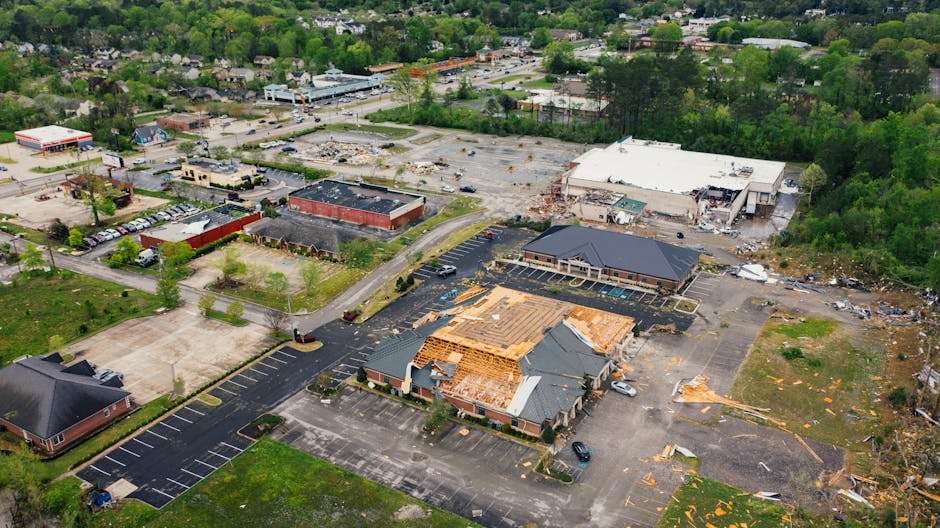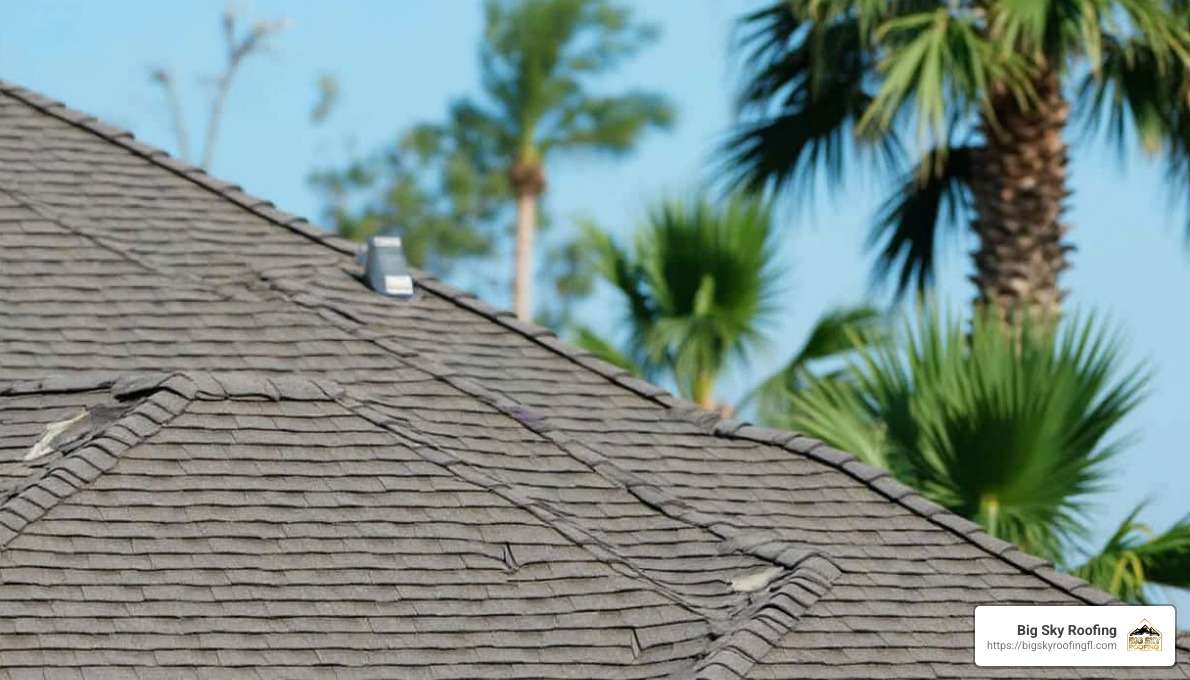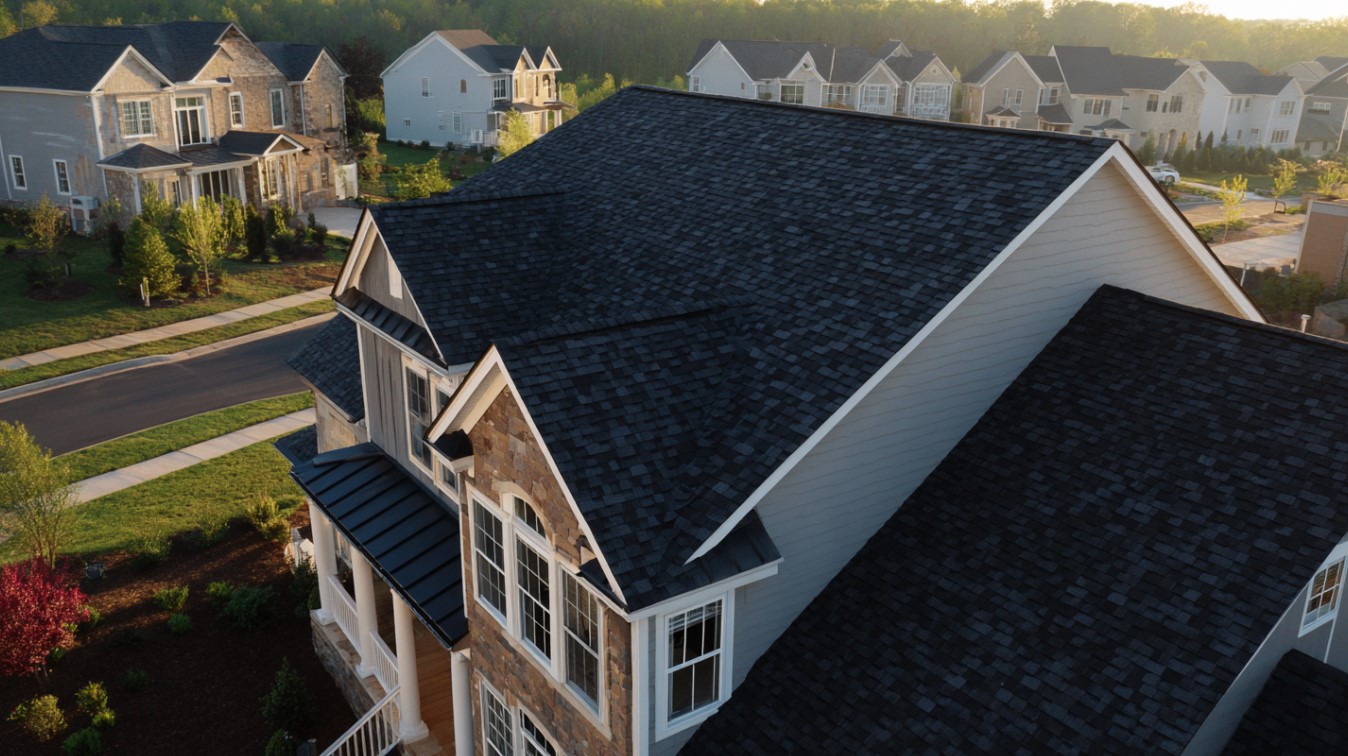The Ultimate Guide to Building a Hurricane-Proof Roof
•
Written By

Understanding the Risks: Why You Need a Hurricane-Proof Roof
In Florida, where hurricanes are as regular as sunshine, understanding the risks of a poorly constructed roof is crucial. Hurricanes bring not just torrential rain but devastating winds that can reach up to 156 mph or more, as categorized by the Saffir-Simpson Hurricane Wind Scale. These winds exert intense pressure on roofs, leading to wind uplift—a phenomenon where roofs are literally lifted off homes.

Flying debris, another threat, turns everyday objects into projectiles that can cause significant damage. In addition, heavy rainfall during hurricanes can lead to leaks and water damage, compounding the financial and safety risks of inadequate roofing.
Scientific research highlights that certain home shapes and roofs withstand hurricanes better than others. For example, hip roofs with four slopes have been shown to provide better resistance against wind uplift compared to gable roofs. Understanding these risks and construction techniques is essential for safeguarding your home and family.
Selecting the Right Materials for Your Hurricane-Proof Roof
When the skies darken and hurricane warnings flash across your TV screen, there’s nothing more reassuring than knowing your roof can weather the storm. Here in Florida, selecting the right materials for your hurricane-proof roof isn’t just about home improvement—it’s about peace of mind for you and your family.
Metal Roofing: The Gold Standard for Hurricane Resistance
If you’re serious about hurricane protection, metal roofing stands tall as the champion of storm-resistant materials. These sturdy systems can withstand punishing winds up to 150 mph—enough to handle most hurricanes that sweep through Sumter, Lake, and Marion counties.
What makes metal roofing particularly valuable is its impressive lifespan of 40-70 years, meaning your investment continues protecting your home for decades. Beyond storm resistance, you’ll enjoy lower insurance premiums, improved energy efficiency (those summer cooling bills will thank you), and a roof that stands strong against our Florida sun, rain, and wind.
More info about Metal Roof Hurricane Proof
Impact-Resistant Shingles: Balancing Cost and Protection
Not everyone can fit metal roofing into their budget, and that’s perfectly okay. Impact-resistant shingles offer an excellent middle ground between protection and affordability. These specialized shingles undergo rigorous UL 2218 impact testing—essentially having steel balls dropped on them from varying heights to simulate hail and flying debris.
With wind resistance ratings up to 130 mph, these shingles can handle most hurricanes that blow through Citrus, Hernando, and Orange counties. They typically last 20-30 years and come in various styles that maintain your home’s aesthetic appeal while significantly upgrading its hurricane readiness.
More info about Hurricane Resistant Roofing Materials
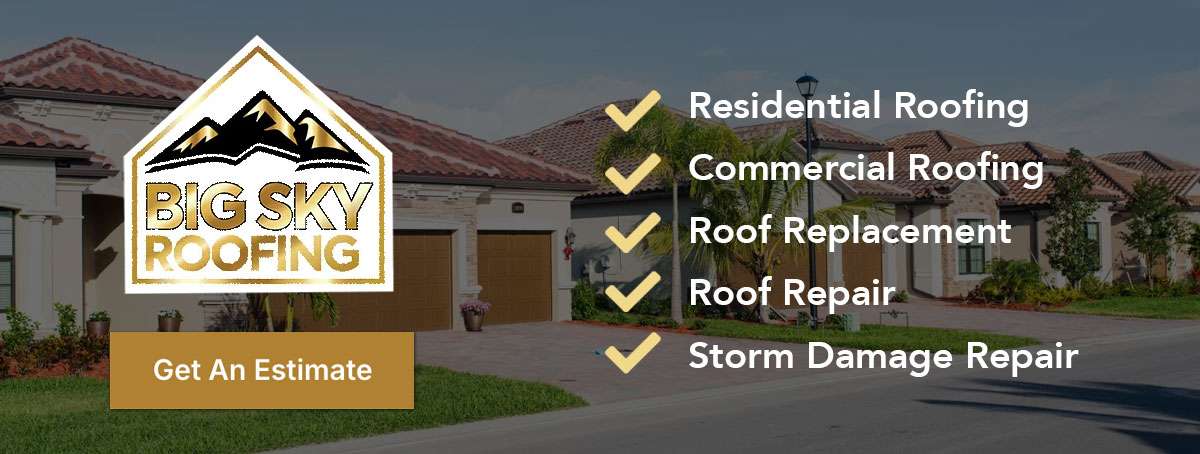
Comparing Roofing Materials and Wind Resistance
When planning your hurricane-proof roof, understanding how different materials perform can help you make the best choice for your specific situation
Beyond the materials themselves, don’t overlook the importance of quality fasteners and connectors. Even the best roofing material won’t perform to its potential if it’s secured with substandard hardware. Corrosion-resistant connectors specifically designed for Florida’s humid, salty air are essential components of any truly storm-resistant roof system.
Material selection is just one piece of the hurricane-proofing puzzle. The installation quality matters just as much as what you’re installing—something we’ve learned from helping homeowners across Central Florida protect their homes for over 25 years.
Designing Your Roof for Maximum Hurricane Resistance
When you’re living in Florida’s hurricane-prone areas, the design of your roof isn’t just about aesthetics—it’s about survival. As a homeowner in Sumter, Lake, Citrus, Hernando, Orange, or Marion county, understanding how to build a hurricane-proof roof starts with smart design choices that can make all the difference when those powerful storms roll in.
The Importance of Roof Shape and Slope
Not all roof designs are created equal when it comes to hurricane resistance. Hip roofs, with their four sloping sides, have proven to be hurricane heroes compared to their gable counterparts. Why? Because these four-sided wonders distribute wind pressure more evenly across your entire roof structure.
When those 120+ mph winds come calling, a hip roof doesn’t give them much to grab onto. This design naturally reduces wind uplift—that dangerous force that tries to peel your roof away from your home like the lid off a sardine can.
The magic number for roof slope appears to be about 30 degrees. This pitch offers that sweet spot between sturdy hurricane resistance and practical design. Too flat, and you’ll collect water; too steep, and you’ll catch wind like a sail.
Scientific research backs this up. Studies published in Science Daily confirm that hip roofs significantly outperform other designs during extreme weather events, reducing the dangerous wind loads that can compromise your home’s structural integrity.

How to Build a Hurricane-Proof Roof Structure
The strongest roof in the world won’t protect you if it separates from your house. That’s why the connection between your roof and walls deserves special attention when building a hurricane-proof roof.
Hurricane straps and clips are your best friends here. These unassuming pieces of metal create a continuous load path from your roof all the way down to your foundation. Think of them as the safety belts for your home—they keep everything secured when the wind tries to tear things apart.
Proper roof truss anchoring is essential too. Each truss should be firmly connected to your home’s wall structure, creating a unified system that can flex slightly during high winds without failing. It’s often not the direct force of wind that causes roof failure, but the repeated lifting and pushing that gradually weakens connections.
When designing overhangs for your Florida home, less is more. While those wide, shady eaves might look lovely and keep the sun off your windows, they give hurricanes more leverage to lift your roof. Keeping overhangs to a minimum—ideally under 20 inches—reduces this risk significantly.
The infographic above shows various roof-to-wall connection methods that can make the difference between a roof that stays put and one that ends up in the neighbor’s yard. These connections aren’t just good practice—they’re essential for anyone serious about how to build a hurricane-proof roof in Florida’s storm-prone regions.
The best roof designs work with nature, not against it. By incorporating these proven design elements, you’ll create a roof system that stands ready to face whatever the 2025 hurricane season throws your way.
Step-by-Step Guide: How to Build a Hurricane-Proof Roof
Florida homeowners know all too well that hurricane season brings sleepless nights worrying about whether your roof will hold up against Mother Nature’s fury. Building a truly hurricane-resistant roof isn’t just about using premium materials—it’s about thoughtful design and meticulous construction. Let’s walk through the essential steps to create a roof that stands strong when those tropical storms come calling.
Step 1: Reinforce Roof-to-Wall Connections
The most common reason roofs fail during hurricanes is poor connection to the walls. Hurricane straps are your best defense here—these metal connectors create a continuous load path from your roof to your foundation.
When installing these crucial components, use corrosion-resistant hardware specifically designed for Florida’s humid climate. These connections are only as strong as their installation—each strap should be firmly secured with the proper number of nails or screws according to manufacturer specifications.
Step 2: Choose High-Quality Roofing Materials
Your roofing material is your home’s first line of defense against hurricane-force winds and driving rain. Metal roofing shines here with its ability to withstand winds up to 150 mph—perfect for those Category 4 storms that occasionally threaten our Central Florida communities.
If metal doesn’t suit your aesthetic or budget, impact-resistant shingles offer a solid alternative. Look for products with a Class 4 impact rating and wind resistance of at least 130 mph. Don’t forget the underlayment! A high-quality, water-resistant barrier beneath your roofing material provides crucial backup protection against water intrusion when shingles or panels are damaged.
Step 3: Optimize Roof Design
When it comes to how to build a hurricane proof roof, shape matters tremendously. Hip roofs with their four-sided, sloped design perform substantially better in high winds than their gable counterparts. The ideal slope is about 30 degrees—steep enough to resist uplift but not so steep that it creates excessive wind resistance.
Keep those roof overhangs to 20 inches or less. While longer overhangs might look charming, they give hurricane winds more surface area to push against, potentially tearing your roof off. Proper ventilation is another often-overlooked design element that helps equalize pressure during storms and prevents moisture damage year-round.

Step 4: Secure Roof Decking and Underlayment
Your roof decking—typically plywood or oriented strand board (OSB)—needs to be properly secured to resist uplift forces. Use ring-shank nails spaced 4 inches apart at the edges and 6 inches in the field for maximum holding power.
For truly hurricane-resistant construction, consider a peel-and-stick membrane underlayment that covers the entire roof deck. This waterproof barrier remains intact even if your primary roofing material gets damaged. Seal all joints with appropriate flashing and weatherproofing compounds to create a watertight system that can withstand Florida’s notorious hurricane downpours.
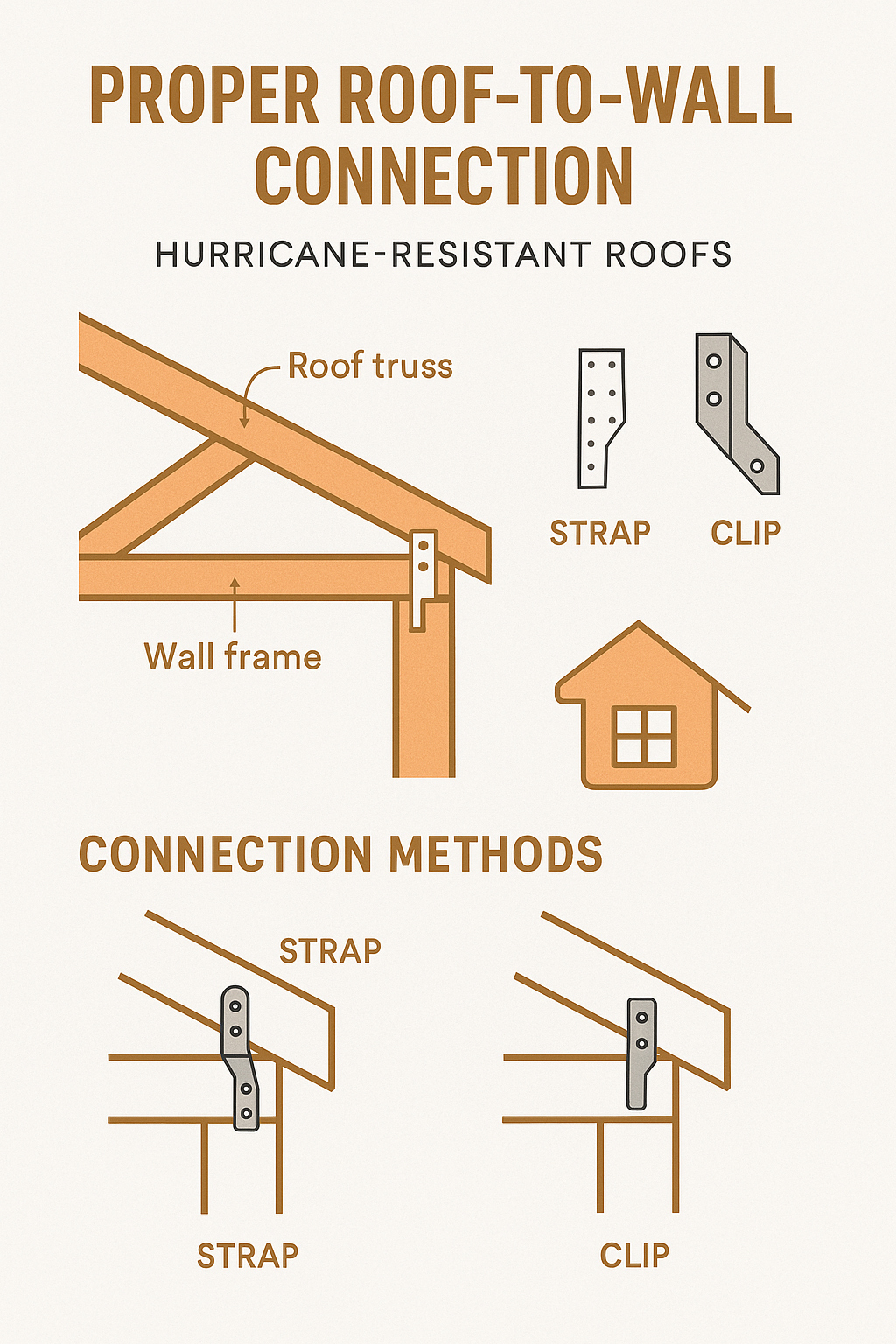
Step 5: Regular Maintenance and Inspection
Even the best-built hurricane-resistant roof needs regular care to maintain its protective qualities. Mark your calendar for a thorough pre-hurricane season inspection every May before the official June 1st start of the 2025 hurricane season.
During these inspections, check for loose or damaged roofing materials, clear debris from gutters and downspouts, and trim back tree branches that could become projectiles during a storm. Small issues can quickly become major vulnerabilities when 100+ mph winds start testing every weakness in your roofing system.
Here in Sumter, Lake, Citrus, Hernando, Orange, and Marion counties, our Big Sky Roofing team has seen how proper maintenance can mean the difference between minor repairs and complete roof replacement after a hurricane.
Frequently Asked Questions about How to Build a Hurricane-Proof Roof
Can I Retrofit My Existing Roof to Make It Hurricane-Proof?
Good news for homeowners who aren’t ready for a complete roof replacement—you can definitely strengthen your existing roof against hurricane damage! Retrofitting is a practical option that many Florida homeowners choose to improve their home’s hurricane resistance without starting from scratch.
The process typically involves adding hurricane straps to reinforce the crucial roof-to-wall connections, which prevents your roof from lifting off during intense winds. Your contractor might also recommend upgrading your roofing materials to more impact-resistant options when it’s time for your next roof replacement.
For older homes in Sumter, Lake, and Citrus counties, these retrofits can make a significant difference in how your home weathers the next big storm. Even modest improvements can dramatically increase your roof’s hurricane resistance and potentially qualify you for insurance discounts in 2025.
What Is the Best Roof Shape for Hurricane Resistance?
When it comes to how to build a hurricane proof roof, shape matters tremendously. Hip roofs consistently outperform other designs in hurricane conditions, and there’s solid science behind this preference.
A hip roof features four slopes that come together at the top, creating a more aerodynamic profile that allows hurricane-force winds to flow over rather than push against the structure. The ideal slope is around 30 degrees—steep enough to resist wind uplift but not so steep that it creates excess wind resistance.
Many homeowners in Hernando, Orange, and Marion counties are now opting for hip roof designs when building new homes or replacing aging roofs, specifically for their superior wind resistance. The investment pays off during Florida’s hurricane seasons, when your roof design can make the difference between minor repairs and catastrophic damage.
How Much Does It Cost to Build a Hurricane-Proof Roof?
Let’s talk dollars and sense. Building a hurricane-proof roof does require a higher upfront investment, but the long-term value is undeniable. Several factors influence the final price tag:
Material costs vary significantly—metal roofing typically runs 2-3 times the cost of standard asphalt shingles, but offers superior protection and longevity. Impact-resistant shingles fall somewhere in between.
Design complexity plays a role too. Hip roofs require more materials and labor than simple gable designs, adding to the initial expense.
Professional installation is absolutely essential—this is definitely not a DIY project! Proper installation by experienced professionals like our team at Big Sky Roofing ensures that all hurricane-resistant features perform as intended when severe weather strikes.
While you might spend 20-40% more compared to a standard roof installation, consider this: a single hurricane can cause tens of thousands in damage to an inadequately protected home. Many Central Florida homeowners find that the peace of mind alone is worth the investment, not to mention potential insurance premium reductions and increased home value.
When it comes to protecting your family and property from Florida’s 2025 hurricane season, cutting corners on your roof is never a wise economy.
Conclusion
When it comes to protecting your home from nature’s fury, building a hurricane-proof roof isn’t just a good idea—it’s essential for Florida homeowners. The peace of mind that comes from knowing your family and property are secure during the 2025 storm season is truly priceless.
At Big Sky Roofing, we’ve weathered many storms alongside our Central Florida neighbors. With over 25 years of experience under our tool belts, we’ve seen how proper roof construction makes all the difference when hurricane winds come calling. Our team brings that knowledge to every project in Sumter, Lake, Citrus, Hernando, Orange, and Marion counties.
Creating a hurricane-resistant roof isn’t a DIY weekend project. It requires professional expertise to ensure that every component—from the structural reinforcements to the material selection—works together as a complete system. The investment you make today in hurricane-proofing your roof could save you thousands in potential damage and heartache tomorrow.
Your home is likely your biggest investment, but more importantly, it’s where your family’s memories are made. Don’t leave its protection to chance. Partner with professionals who understand the unique challenges of Florida’s climate and can provide solutions custom to your specific needs.
Whether you’re building new construction or upgrading your existing home, Big Sky Roofing is here to help you steer the complexities of how to build a hurricane-proof roof that stands strong for decades to come. Our commitment to superior craftsmanship and warm, personalized service has made us Central Florida’s trusted roofing partner through calm skies and stormy weather alike.

